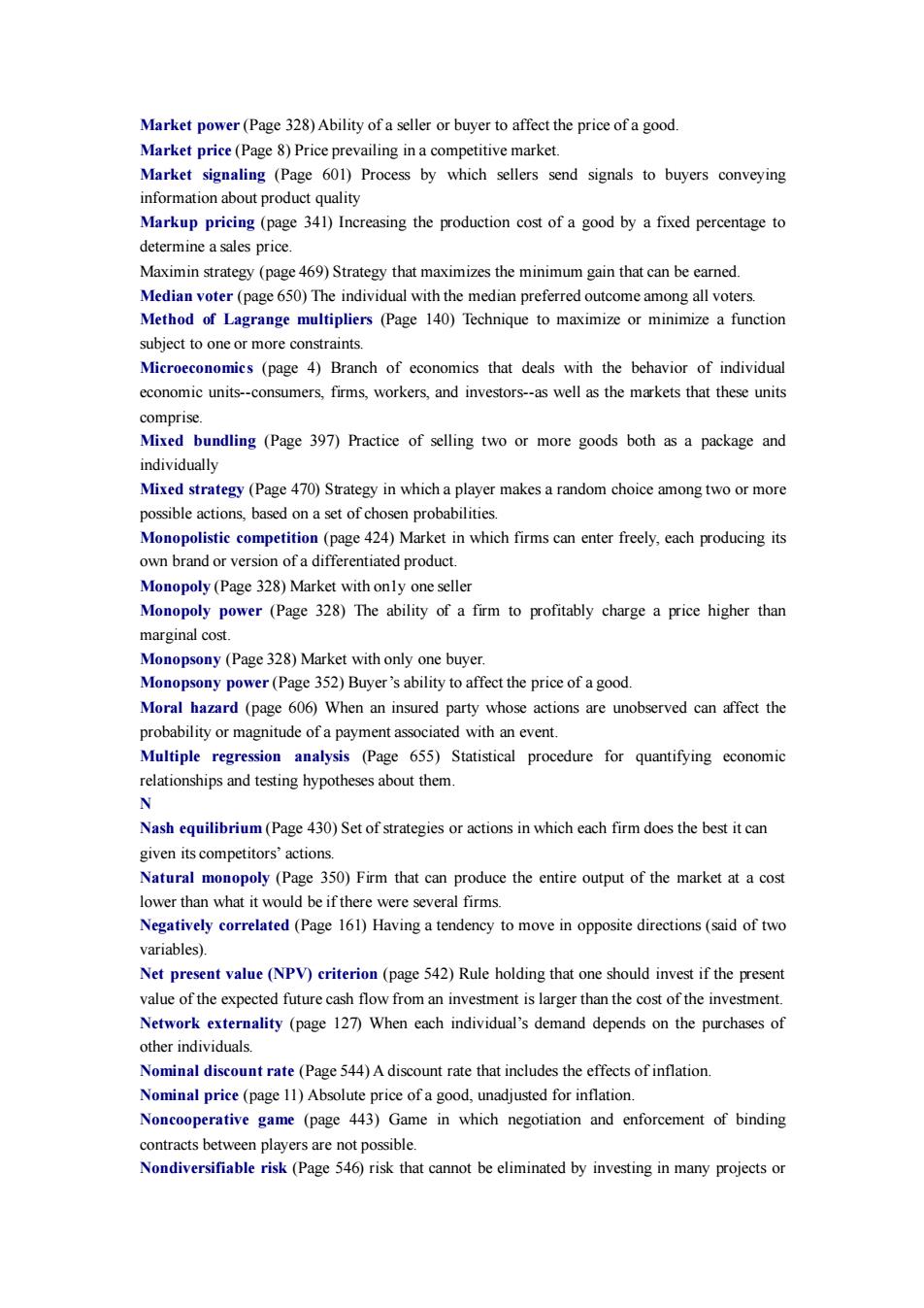正在加载图片...

Market power(Page 328)Ability of a seller or buyer to affect the price of a good. Market price(P)Price prevaling market Market signaling (Page 601)Process by which sellers send signals to buyers conveying information about product quality Markup pricing(page 341)Increasing the production cost of a good by a fixed percentage to determine a sales price. Maximin strategy (page 69)Strategy that theminimumgain that can ter(page 650)The individual with the median preferred outcome among all voters Method of Lagrange multipliers (Page 140)Technique to maximize or minimize a function subject to one or more constraints. Microeconomics (page 4)Branch of economics that deals with the behavior of individual economic firms,workers,and investorsas well as the makets that these units Mixed bundling (Page 397)Practice of selling two or more goods both as a package and individually Mixed strategy (Page 470)Strategy in which a player makes a random choice among two or more possible actions based on a set of chosen probabilities Mono competition (page 424)Market in which firms can enter freely,each producing its own brand or version ofa differentiated produc Monopoly(Page 328)Market with only one seller Monopoly power (Page 328)The ability of a firm to profitably charge a price higher than marginal cost. Monopsony (Page 328)Market wit Mon nopsony power(Page e35)Buyer's ability to affect the price of agoo Moral hazard(page 606)When an insured party whose actions are unobserved can affect the probability or magnitude of a payment associated with an event Multiple regression analysis (Page 655)Statistical procedure for quantifying economic relationshins and testing hypotheses about them. Nashequilibrium(Page 430)Set of strategies or actions in which each firm does the best it can given its competitors'actions Natural monopoly (Page 350)Firm that can produce the entire output of the market at a cost lower than what it would be if there were several firms. Negatively orreated (Page 161)Having a tendency to move in opposite directions(said of two Net present value(NPV)criterion(page 542)Rule holding that one should invest if the present value of the expected future cash flow from an investment is larger than the cost of the investment. Network externality (page 127When each individual's demand depends on the purchases of other individuals is(Page 544)Adiscount rate that includes the effects Nominal price (page 11)Absolute price of a good,unadjusted for inflation. Noncooperative game (page 443)Game in which negotiation and enforcement of binding contracts between plavers are not possible. Nondiversifiable risk(Page 546)risk that cannot be eliminated by investing in many projects orMarket power (Page 328) Ability of a seller or buyer to affect the price of a good. Market price (Page 8) Price prevailing in a competitive market. Market signaling (Page 601) Process by which sellers send signals to buyers conveying information about product quality Markup pricing (page 341) Increasing the production cost of a good by a fixed percentage to determine a sales price. Maximin strategy (page 469) Strategy that maximizes the minimum gain that can be earned. Median voter (page 650) The individual with the median preferred outcome among all voters. Method of Lagrange multipliers (Page 140) Technique to maximize or minimize a function subject to one or more constraints. Microeconomics (page 4) Branch of economics that deals with the behavior of individual economic units-consumers, firms, workers, and investors-as well as the markets that these units comprise. Mixed bundling (Page 397) Practice of selling two or more goods both as a package and individually Mixed strategy (Page 470) Strategy in which a player makes a random choice among two or more possible actions, based on a set of chosen probabilities. Monopolistic competition (page 424) Market in which firms can enter freely, each producing its own brand or version of a differentiated product. Monopoly (Page 328) Market with on1y one seller Monopoly power (Page 328) The ability of a firm to profitably charge a price higher than marginal cost. Monopsony (Page 328) Market with only one buyer. Monopsony power (Page 352) Buyer’s ability to affect the price of a good. Moral hazard (page 606) When an insured party whose actions are unobserved can affect the probability or magnitude of a payment associated with an event. Multiple regression analysis (Page 655) Statistical procedure for quantifying economic relationships and testing hypotheses about them. N Nash equilibrium (Page 430) Set of strategies or actions in which each firm does the best it can given its competitors’ actions. Natural monopoly (Page 350) Firm that can produce the entire output of the market at a cost lower than what it would be if there were several firms. Negatively correlated (Page 161) Having a tendency to move in opposite directions (said of two variables). Net present value (NPV) criterion (page 542) Rule holding that one should invest if the present value of the expected future cash flow from an investment is larger than the cost of the investment. Network externality (page 127) When each individual’s demand depends on the purchases of other individuals. Nominal discount rate (Page 544) A discount rate that includes the effects of inflation. Nominal price (page 11) Absolute price of a good, unadjusted for inflation. Noncooperative game (page 443) Game in which negotiation and enforcement of binding contracts between players are not possible. Nondiversifiable risk (Page 546) risk that cannot be eliminated by investing in many projects or